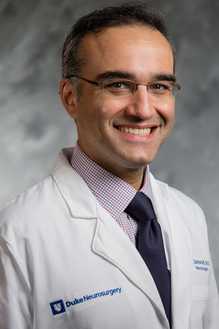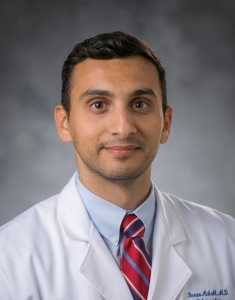Anterior Skull Base Resection of Esthesioneuroblastoma (Endoscopic)
Transcription
CHAPTER 1
This is an endoscopic transcribiform approach for a small olfactory neuroblastoma limited to the right olfactory cleft. We start by looking into the right nasal cavity using the zero-degree endoscope. And we see the prior biopsy site with Gelfoam, medial to the middle turbinate. We begin by medializing the middle turbinate. And we resect the middle turbinate using scissors. Once the middle turbinate is removed, the debrider is used to remove the remnants. And the vascular pedicle often needs to be cauterized. We then perform - removal of the uncinate process. This is followed by a maxillary antrostomy, and - total ethmoidectomy. The lamina papyracea needs to be fully exposed. Here, the sphenoid sinus ostium is identified and widened, and the Coblator is used to obtain hemostasis.
Here we're making the hemitransfixion incision on the left side. And the mucoperichondrial flap is raised from the left septum. Very, very limited septoplasty is performed in order to optimize exposure to the left nasal cavity.
We now visualize the left middle turbinate, - which is then resected. And maxillary antrostomy, total ethmoidectomy, and sphenoidotomy are also performed on this side.
Here, we are using an angled endoscope with curved instruments to perform left frontal sinusotomy This is also done on the right side.
CHAPTER 2
Here, we're using an extended-length needle tip bovie. To raise - a nasoseptal flap on the left side. Incisions are made superiorly - and inferiorly. The details of this will be discussed in a separate video. The septal flap is then tucked away in the nasopharynx.
CHAPTER 3
Here on the right side, we're completing the cuts to perform a superior septectomy, which will allow a binostril approach to the anterior skull base. The Coblator is effective at attaining hemostasis along the anterior skull base. Now we can see the cribriform plate, lateral lamella, and fovea ethmoidalis on both sides.
CHAPTER 4
The remainder of the mucosa is removed, and a high-speed drill with a diamond burr is used to thin the bone of the anterior skull base. This is performed with the drill and the suction with an assistant holding the endoscope. The bone is then removed to expose the dura. Here, the Coblator is used to coagulate the left anterior ethmoid artery. The Kerrison rongeur can also be used to - remove bone - to expose the dura. Here, we are drilling the bone of the crista galli - as well as the planum sphenoidale posteriorly. The bone is removed back to the sphenoid sinuses. Here, we see bilateral frontal sinuses, which serve as the anterior limit of dissection. Our neurosurgery colleague then joins us. We are using the bipolar to obtain hemostasis. This is the right anterior ethmoid artery, which we are cauterizing. The bone is further removed laterally, along the right ethmoid groove.
CHAPTER 5
The dural cuts are now being made with an 11 blade as well as scissors. Here, the falx cerebri is being cut - in order to complete the dural resection. We are using a zero-degree endoscope with the patient's head in a slightly-extended position. The cut along the falx cerebri is taken posteriorly - with care to protect the frontal lobes.
We can see the left olfactory bulb and the left olfactory nerve, inferior to the scissors. The olfactory bulbs are respected as well.
CHAPTER 6
Once the dura is resected, we then perform a skull base reconstruction using a multi-layer technique. Some Surgicel has been placed - and we are now inlaying a collagen-based, dural graft. Here, the nasoseptal flap is retrieved from the nasopharynx - and positioned - over the anterior skull base defect.




